20分でできる!齿补尘补谤颈苍.贵辞谤尘蝉入门
30 likes18,639 views
2016.05.07 JXUGC #13 東京 緊急開催 Xamarin のすべて!
1 of 60
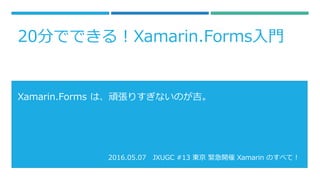

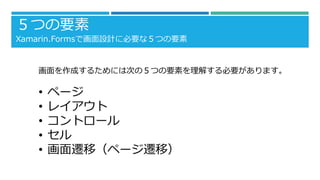
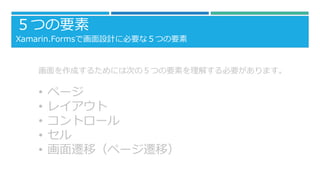
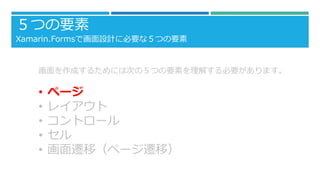
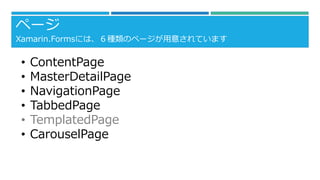
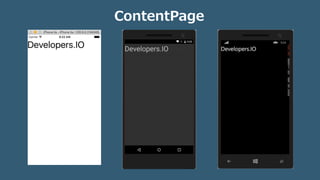

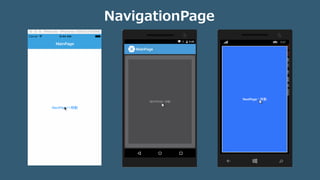

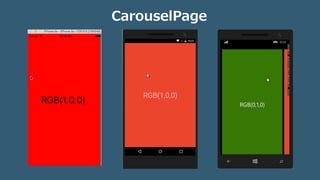
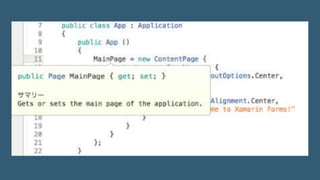

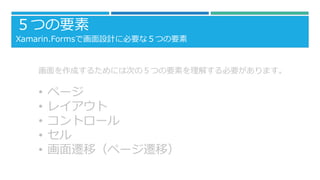
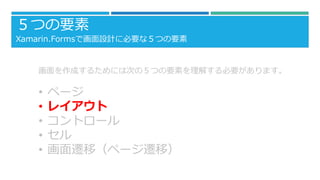
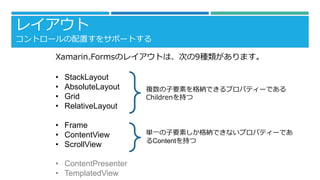
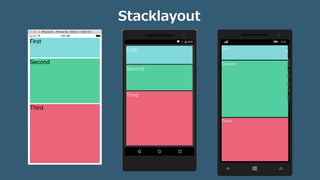
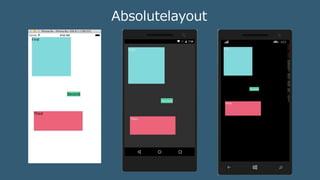
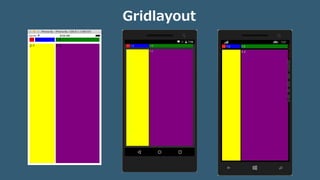
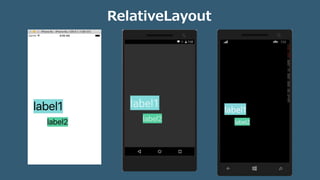
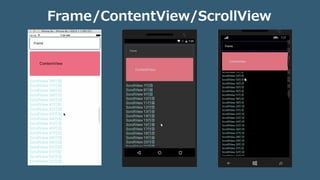
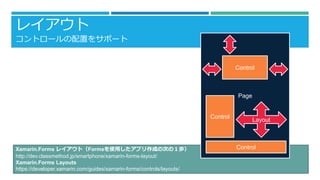
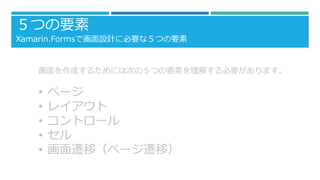
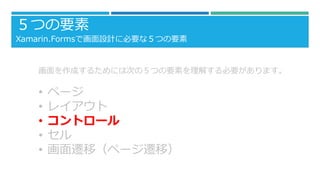
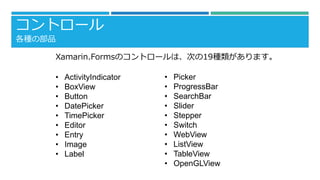
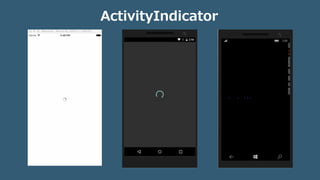

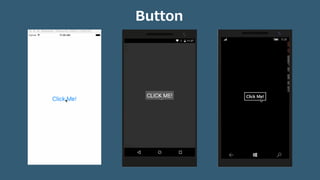
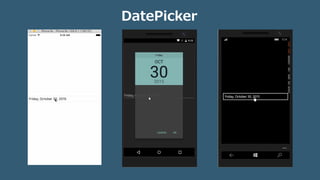

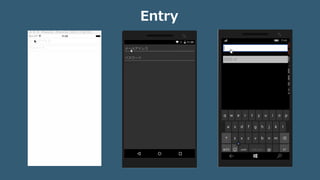


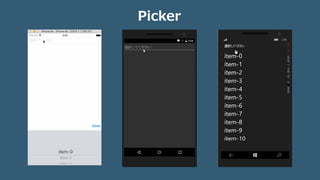
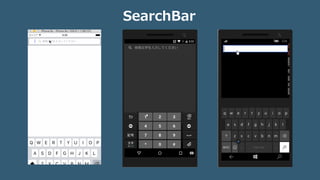
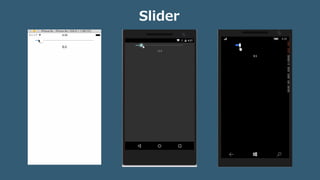
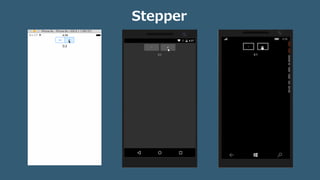
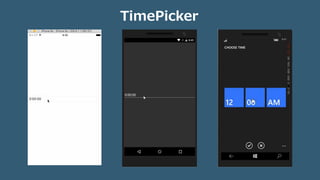
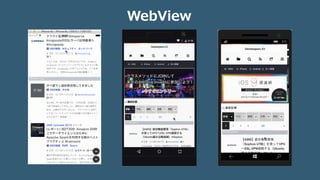

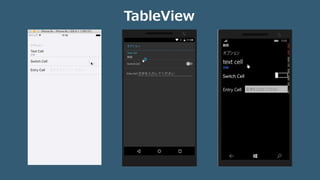

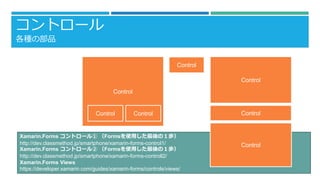
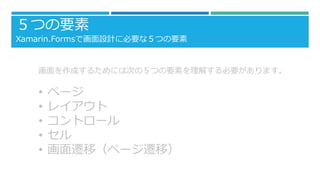

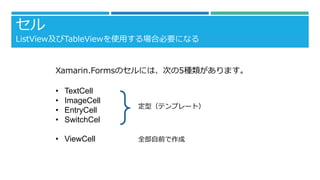
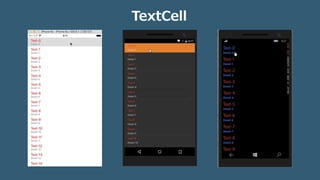
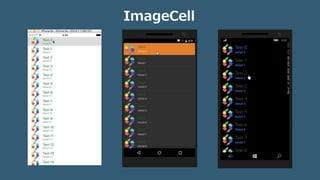
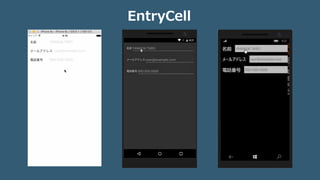
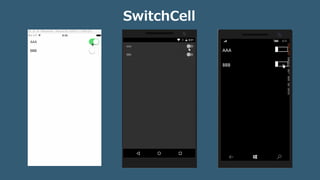
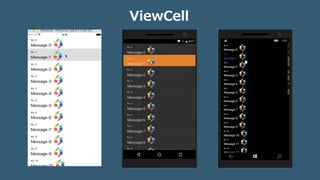


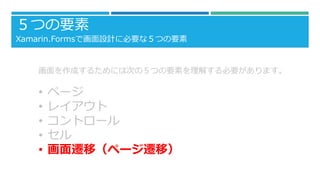
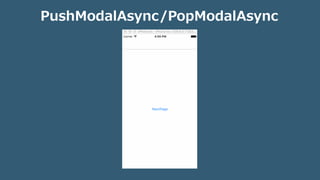
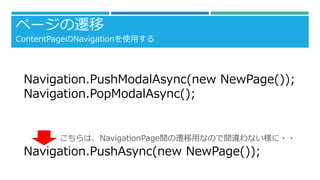
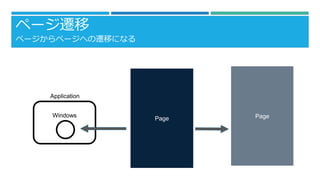
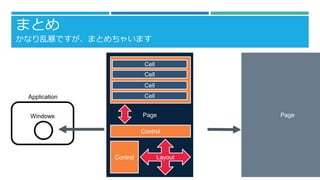

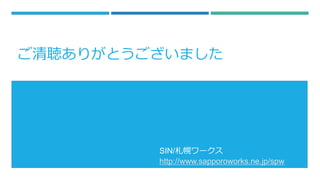
Ad
Recommended
Designing for User Experience (UX) with Atlassian Tools
Designing for User Experience (UX) with Atlassian ToolsAtlassian
?
The document discusses integrating design and development. It outlines 5 steps to solve challenges: 1) braindump to brief, 2) brief to wireframes, 3) wireframes to design, 4) design to implementation, and 5) implementation to validation. Key points include using tools like JIRA and Confluence for collaboration, bringing designs to life with prototypes, and validating designs through internal and external testing.03 顧客旅程-覺知與進化20160322
03 顧客旅程-覺知與進化20160322 觉旅股份有限公司
?
顾客旅程的觉知与进化强调了关键体验点与基础体验点的结合,以创造超值的顾客体验。透过顾客旅程地图与同理心地图,可以深入理解顾客任务,并主动进行服务调整以满足顾客的需求。持续进化与适应市场变化是确保顾客旅程价值的关键。Progressive Lightmapper: An Introduction to Lightmapping in Unity
Progressive Lightmapper: An Introduction to Lightmapping in UnityUnity Technologies
?
The document serves as an introduction to the Progressive Lightmapper in Unity, detailing optimization techniques for faster light mapping and the overall mechanics involved in the baking process. It includes practical tips for managing texel counts, understanding light modes, and utilizing GPU capabilities for improved performance. Future developments mentioned include support for multiple GPUs and enhanced probe handling."Embedded Lucas-Kanade Tracking: How it Works, How to Implement It, and How t...
"Embedded Lucas-Kanade Tracking: How it Works, How to Implement It, and How t...Edge AI and Vision Alliance
?
The document presents the Lucas-Kanade tracking algorithm, an established method for optical flow used in various applications like automotive systems and human-device interaction. It describes the algorithm's functioning, advantages, and limitations, alongside a practical implementation using Texas Instruments' vision library. Additionally, it highlights ongoing developments in computer vision while cautioning about the quality of open-source libraries related to the algorithm.Metrics Driven Design by Joshua Porter
Metrics Driven Design by Joshua PorterAndrew Chen
?
The document discusses metrics-driven design and highlights several key points:
1) It describes how Google tested 41 shades of blue to determine the optimal color and how testing small variations can have large impacts.
2) It contrasts intuition-driven and data-driven design, noting that while data-driven design removes subjectivity, it can also prevent daring decisions.
3) It emphasizes that metrics should measure the effectiveness of a business by tracking things like acquisition, conversion, engagement, and satisfaction over time.Lec15 sfm
Lec15 sfmBaliThorat1
?
Three key points about structure from motion:
1. Given multiple images of 3D points, structure from motion aims to estimate the 3D structure and camera motion from 2D point correspondences across images.
2. For affine cameras, factorization methods can be used to decompose the measurement matrix and obtain the motion and structure matrices up to an affine ambiguity.
3. For projective cameras, an iterative procedure alternates between factorization to estimate motion/structure and re-solving for depths to handle the projective ambiguity. At least 7 point correspondences are needed for a two-camera case.08_?? ?? ????? ???
08_?? ?? ????? ???noerror
?
This document provides an overview of physics engine usage for game physics programming. It introduces key concepts in physics such as kinematics, calculus, and numeric solutions. It also summarizes the Box2D and PhysX physics engines, including collision detection methods, constraints, joints and example code reviews. The goal is to provide background information for implementing physics in games without focusing on specific implementation details.[NDC2017] ????? ?? ??? ???? - VAE? ??? ??? ?? ?? ?? ??
[NDC2017] ????? ?? ??? ???? - VAE? ??? ??? ?? ?? ?? ??Hwanhee Kim
?
This presentation by Hwanhee Kim from Nexon explores the use of variational autoencoders (VAE) in generating game content through deep learning techniques. It discusses the fundamentals of autoencoders, the advantages of variational approaches, and showcases examples such as dungeon shapes and character portraits. The work aims to enhance content creation efficiency in game development while addressing the challenges of data usage and model optimization.Scrum and xp from the trenches (1st edition, Chinese)
Scrum and xp from the trenches (1st edition, Chinese)Jen-Chieh Ko
?
本书介绍了Henrik Kniberg的实践经验,主要讨论Scrum和XP的方法以及如何有效管理产物Backlog和Sprint计划。书中着重于实际操作而非理论,提供了对新手团队特别有用的指导。通过遵循书中的实践,团队可以更好地实现敏捷开发并提高绩效。Introduccion a MVU con CometLuis Beltran
?
El documento presenta una introducción a MVU (Model-View-Update) y su aplicación en el desarrollo de aplicaciones utilizando .NET MAUI y Comet. Se discuten los conceptos fundamentales del patrón MVU, sus ventajas y cómo Comet funciona como un nuevo toolkit para crear interfaces de usuario en C#. Además, se proporciona información sobre herramientas, demos y recursos adicionales para profundizar en el tema.Intelligent Image Enhancement and Restoration - From Prior Driven Model to Ad...
Intelligent Image Enhancement and Restoration - From Prior Driven Model to Ad...Wanjin Yu
?
The document presents an overview of a tutorial focused on intelligent image and video editing, specifically addressing rain removal from images. It discusses various techniques for image degradation modeling, prior embedding for deep rain removal, and advancements in rain streak detection and removal using deep learning methods. Additionally, it highlights related workshops, challenges, and the performance of different methods evaluated for enhancing image quality in adverse weather conditions.Jobs-To-Be-Done Theory
Jobs-To-Be-Done TheoryAlex Kehr
?
The Jobs-To-Be-Done theory states that companies should focus on the "jobs" or tasks customers want done, rather than the products themselves. Understanding the customer's job enables better innovation to meet unmet needs. Companies can also define their markets and products around the jobs they help complete. Focusing on getting the customer's job done better positions a company for long-term success.[2018] ????? ?? ???
[2018] ????? ?? ???NHN FORWARD
?
??? ?? ? ???????? ??? ?? ? ??? ??? ?? ????. ????? ???? ??? ????? ???? ?????, ?? ??? ???? ???? ????? ?? ? ??????? ??? ?? ???? ??? ?? ???? ????.
??
1. ?? ??? ??
2. PWA ??? ??
3. ??? ??? ??
??
- ????? ?? ??? ???? ?? ???
- ?? ? ???? ??? ??? ? ?? ?? ????? ???
- ??/??? ???? ?? ??? ?? ?? ???Computer Vision: Shape from Specularities and Motion
Computer Vision: Shape from Specularities and MotionDamian T. Gordon
?
The document discusses using specularities and motion to extract surface shape from images. Specifically, it discusses using:
1) Structured highlights from a spherical array of light sources to determine surface orientation of specular surfaces from the detected highlights.
2) Photometric stereo with multiple light source positions to determine surface orientation of both diffuse and specular surfaces.
3) Stereo techniques using highlights detected from multiple camera views to reconstruct the 3D shape of specular surfaces.Xamarin.forms Shell + Navigation
Xamarin.forms Shell + NavigationJames Montemagno
?
Xamarin is an open-source app platform from Microsoft that allows developers to create performant applications for iOS, Android, macOS, watchOS, and tvOS using .NET and C#. It includes tools like Xamarin.Forms for building cross-platform user interfaces and Xamarin.Essentials for accessing native device features. The platform supports a shared C# business logic codebase with full access to native APIs for high performance.Java Crash分析(2012-05-10)
Java Crash分析(2012-05-10)Kris Mok
?
这篇文档分析了闯补惫补虚拟机(闯痴惭)崩溃的原因及应对策略,指出崩溃可能由闯痴惭内部缺陷、应用代码错误或外部环境影响引起,并提供了崩溃日志和核心转储的检查方法。文中强调了事前准备和故障现象保护的重要性,以便于后续的故障分析和修复。最后,提供了一些观察崩溃日志时需要注意的关键点和急救措施,以帮助开发者迅速定位问题。Physically Based and Unified Volumetric Rendering in Frostbite
Physically Based and Unified Volumetric Rendering in FrostbiteElectronic Arts / DICE
?
The document outlines advancements in physically-based volumetric rendering techniques implemented in the Frostbite engine, presented by Sebastien Hillaire at SIGGRAPH 2015. It discusses the integration of scattering, lighting, and shadowing interactions to enhance visual quality in real-time rendering, along with the use of 'froxel' technology and voxelizations for efficient data handling. The work demonstrates a comprehensive approach to volumetric rendering, targeting improved realism in games powered by the Frostbite engine.齿补尘补谤颈苍.蹿辞谤尘蝉とカスタムコントロールの话
齿补尘补谤颈苍.蹿辞谤尘蝉とカスタムコントロールの话Masuda Tomoaki
?
第2回 Japan Xamarin User Group Conference 東日本編
2014/11/22 の発表スライドです。
Xamarin.Forms の概要と拡張(カスタムコントロール、DependencyService、カスタムレンダラ)More Related Content
What's hot (20)
"Embedded Lucas-Kanade Tracking: How it Works, How to Implement It, and How t...
"Embedded Lucas-Kanade Tracking: How it Works, How to Implement It, and How t...Edge AI and Vision Alliance
?
The document presents the Lucas-Kanade tracking algorithm, an established method for optical flow used in various applications like automotive systems and human-device interaction. It describes the algorithm's functioning, advantages, and limitations, alongside a practical implementation using Texas Instruments' vision library. Additionally, it highlights ongoing developments in computer vision while cautioning about the quality of open-source libraries related to the algorithm.Metrics Driven Design by Joshua Porter
Metrics Driven Design by Joshua PorterAndrew Chen
?
The document discusses metrics-driven design and highlights several key points:
1) It describes how Google tested 41 shades of blue to determine the optimal color and how testing small variations can have large impacts.
2) It contrasts intuition-driven and data-driven design, noting that while data-driven design removes subjectivity, it can also prevent daring decisions.
3) It emphasizes that metrics should measure the effectiveness of a business by tracking things like acquisition, conversion, engagement, and satisfaction over time.Lec15 sfm
Lec15 sfmBaliThorat1
?
Three key points about structure from motion:
1. Given multiple images of 3D points, structure from motion aims to estimate the 3D structure and camera motion from 2D point correspondences across images.
2. For affine cameras, factorization methods can be used to decompose the measurement matrix and obtain the motion and structure matrices up to an affine ambiguity.
3. For projective cameras, an iterative procedure alternates between factorization to estimate motion/structure and re-solving for depths to handle the projective ambiguity. At least 7 point correspondences are needed for a two-camera case.08_?? ?? ????? ???
08_?? ?? ????? ???noerror
?
This document provides an overview of physics engine usage for game physics programming. It introduces key concepts in physics such as kinematics, calculus, and numeric solutions. It also summarizes the Box2D and PhysX physics engines, including collision detection methods, constraints, joints and example code reviews. The goal is to provide background information for implementing physics in games without focusing on specific implementation details.[NDC2017] ????? ?? ??? ???? - VAE? ??? ??? ?? ?? ?? ??
[NDC2017] ????? ?? ??? ???? - VAE? ??? ??? ?? ?? ?? ??Hwanhee Kim
?
This presentation by Hwanhee Kim from Nexon explores the use of variational autoencoders (VAE) in generating game content through deep learning techniques. It discusses the fundamentals of autoencoders, the advantages of variational approaches, and showcases examples such as dungeon shapes and character portraits. The work aims to enhance content creation efficiency in game development while addressing the challenges of data usage and model optimization.Scrum and xp from the trenches (1st edition, Chinese)
Scrum and xp from the trenches (1st edition, Chinese)Jen-Chieh Ko
?
本书介绍了Henrik Kniberg的实践经验,主要讨论Scrum和XP的方法以及如何有效管理产物Backlog和Sprint计划。书中着重于实际操作而非理论,提供了对新手团队特别有用的指导。通过遵循书中的实践,团队可以更好地实现敏捷开发并提高绩效。Introduccion a MVU con CometLuis Beltran
?
El documento presenta una introducción a MVU (Model-View-Update) y su aplicación en el desarrollo de aplicaciones utilizando .NET MAUI y Comet. Se discuten los conceptos fundamentales del patrón MVU, sus ventajas y cómo Comet funciona como un nuevo toolkit para crear interfaces de usuario en C#. Además, se proporciona información sobre herramientas, demos y recursos adicionales para profundizar en el tema.Intelligent Image Enhancement and Restoration - From Prior Driven Model to Ad...
Intelligent Image Enhancement and Restoration - From Prior Driven Model to Ad...Wanjin Yu
?
The document presents an overview of a tutorial focused on intelligent image and video editing, specifically addressing rain removal from images. It discusses various techniques for image degradation modeling, prior embedding for deep rain removal, and advancements in rain streak detection and removal using deep learning methods. Additionally, it highlights related workshops, challenges, and the performance of different methods evaluated for enhancing image quality in adverse weather conditions.Jobs-To-Be-Done Theory
Jobs-To-Be-Done TheoryAlex Kehr
?
The Jobs-To-Be-Done theory states that companies should focus on the "jobs" or tasks customers want done, rather than the products themselves. Understanding the customer's job enables better innovation to meet unmet needs. Companies can also define their markets and products around the jobs they help complete. Focusing on getting the customer's job done better positions a company for long-term success.[2018] ????? ?? ???
[2018] ????? ?? ???NHN FORWARD
?
??? ?? ? ???????? ??? ?? ? ??? ??? ?? ????. ????? ???? ??? ????? ???? ?????, ?? ??? ???? ???? ????? ?? ? ??????? ??? ?? ???? ??? ?? ???? ????.
??
1. ?? ??? ??
2. PWA ??? ??
3. ??? ??? ??
??
- ????? ?? ??? ???? ?? ???
- ?? ? ???? ??? ??? ? ?? ?? ????? ???
- ??/??? ???? ?? ??? ?? ?? ???Computer Vision: Shape from Specularities and Motion
Computer Vision: Shape from Specularities and MotionDamian T. Gordon
?
The document discusses using specularities and motion to extract surface shape from images. Specifically, it discusses using:
1) Structured highlights from a spherical array of light sources to determine surface orientation of specular surfaces from the detected highlights.
2) Photometric stereo with multiple light source positions to determine surface orientation of both diffuse and specular surfaces.
3) Stereo techniques using highlights detected from multiple camera views to reconstruct the 3D shape of specular surfaces.Xamarin.forms Shell + Navigation
Xamarin.forms Shell + NavigationJames Montemagno
?
Xamarin is an open-source app platform from Microsoft that allows developers to create performant applications for iOS, Android, macOS, watchOS, and tvOS using .NET and C#. It includes tools like Xamarin.Forms for building cross-platform user interfaces and Xamarin.Essentials for accessing native device features. The platform supports a shared C# business logic codebase with full access to native APIs for high performance.Java Crash分析(2012-05-10)
Java Crash分析(2012-05-10)Kris Mok
?
这篇文档分析了闯补惫补虚拟机(闯痴惭)崩溃的原因及应对策略,指出崩溃可能由闯痴惭内部缺陷、应用代码错误或外部环境影响引起,并提供了崩溃日志和核心转储的检查方法。文中强调了事前准备和故障现象保护的重要性,以便于后续的故障分析和修复。最后,提供了一些观察崩溃日志时需要注意的关键点和急救措施,以帮助开发者迅速定位问题。Physically Based and Unified Volumetric Rendering in Frostbite
Physically Based and Unified Volumetric Rendering in FrostbiteElectronic Arts / DICE
?
The document outlines advancements in physically-based volumetric rendering techniques implemented in the Frostbite engine, presented by Sebastien Hillaire at SIGGRAPH 2015. It discusses the integration of scattering, lighting, and shadowing interactions to enhance visual quality in real-time rendering, along with the use of 'froxel' technology and voxelizations for efficient data handling. The work demonstrates a comprehensive approach to volumetric rendering, targeting improved realism in games powered by the Frostbite engine."Embedded Lucas-Kanade Tracking: How it Works, How to Implement It, and How t...
"Embedded Lucas-Kanade Tracking: How it Works, How to Implement It, and How t...Edge AI and Vision Alliance
?
Similar to 20分でできる!齿补尘补谤颈苍.贵辞谤尘蝉入门 (20)
齿补尘补谤颈苍.蹿辞谤尘蝉とカスタムコントロールの话
齿补尘补谤颈苍.蹿辞谤尘蝉とカスタムコントロールの话Masuda Tomoaki
?
第2回 Japan Xamarin User Group Conference 東日本編
2014/11/22 の発表スライドです。
Xamarin.Forms の概要と拡張(カスタムコントロール、DependencyService、カスタムレンダラ)Xamarin.Forms のこれまでとこれから
Xamarin.Forms のこれまでとこれからYoshito Tabuchi
?
iOSコンソーシアムTech WG 定例会#40 (https://iosc.connpass.com/event/102239/) でお話した資料です。
Xamarin 基礎講座
Xamarin 基礎講座Yoshito Tabuchi
?
Xamarin ハンズオン時に使用している Xamarin ネイティブ、Xamarin.Forms の基礎を学ぶスライドです。
(一部コンテンツを Xamarin University から???????しています)Windows Phone / iOS / Android アプリ同時開発のススメ
Windows Phone / iOS / Android アプリ同時開発のススメYoshito Tabuchi
?
2015/7/8 にインフラジスティックス?ジャパン様と共同で開催した Windows Phone / iOS / Android アプリ同時開発のススメ セミナーの資料です。 20191209 JXUGC #26 平日エディション 発表資料. ?Xamarin.Formsの標準UIで
どこまでできるナウなUI?
20191209 JXUGC #26 平日エディション 発表資料. ?Xamarin.Formsの標準UIで
どこまでできるナウなUI? Shuhei Nishizawa
?
20191209 JXUGC #26 平日エディション 発表資料.
?Xamarin.Formsの標準UIで
どこまでできるナウなUI? 齿补尘补谤颈苍.贵辞谤尘蝉概要
齿补尘补谤颈苍.贵辞谤尘蝉概要Hironov OKUYAMA
?
第1回 Japan Xamarin User Group Conference の発表資料です。
資料とサンプルのソースは https://github.com/amay077/jxug_1_xamarin_forms_talkこの辺でXamarin導入による 効果と限界をしっかり把握してみよう MVP Community Camp 2015
この辺でXamarin導入による 効果と限界をしっかり把握してみよう MVP Community Camp 2015 Shinichi Hirauchi
?
Java 及び Objective-C による開発と Xamarin(C#) によるものを比較し、各 OS のライブラリが、見事にラッピングされているようすを確認すると共に、共通コードによるクロスプラットフォーム開発の威力と制限について解説します。 また、デバイス固有の機能が、全てコーディング可能になっている事も紹介します。 本セッションでは、まだ、このツールに触れたことの無い方も、Xamarin 導入の効果と限界が語れるようになる事を目標にします。Xamarin Dev days 2 xamarin.forms ja
Xamarin Dev days 2 xamarin.forms jaAtsushi Nakamura
?
Cross-Platform Native User Interfaces
with Xamarin.FormsXamarin 概要 @ 2014/10/18 わんくま同盟 東京勉強会 #92
Xamarin 概要 @ 2014/10/18 わんくま同盟 東京勉強会 #92Yoshito Tabuchi
?
2014/10/18 わんくま同盟 東京勉強会 #92 ( http://www.wankuma.com/seminar/20141018tokyo92/ )
で発表した資料です。
基本的な内容はあまり変わっていませんが、Evolve 2014 から Sketches のネタを追加しています。Xamarin 概要 2017/01/15
Xamarin 概要 2017/01/15Yoshito Tabuchi
?
2017/1/15(日)に名古屋で開催した OthloEvent #9 [学生限定Xamarinハンズオン] OthloTech x Microsoft Student Partners x JXUG学生支部
https://othlotech.connpass.com/event/45888/
で発表した資料です。Ad
More from Shinichi Hirauchi (20)
最近、ショッピングセンターとかの驻车场で见かける「自动でナンバープレートを认识して决算するやつ」←これ、作ってみました
最近、ショッピングセンターとかの驻车场で见かける「自动でナンバープレートを认识して决算するやつ」←これ、作ってみましたShinichi Hirauchi
?
驰翱尝翱による物体検出モデルをファインチューニングして、カメラに写った车両のナンバープレートを検出し、础滨-翱颁搁で数字等を読み取る手顺を绍介させて顶きます。必要となった大量のデータセットは全部プログラムで自动生成してます。
Developer IO 2024 Odyssey SAMを応用したコンピュータビジョンの話
Developer IO 2024 Odyssey SAMを応用したコンピュータビジョンの話Shinichi Hirauchi
?
Developer IO 2024 Odyssey
SAMを応用したコンピュータビジョンの話Amazon Forecast 機械学習でビジネスの予測と成果を簡単かつ正確に予測する
Amazon Forecast 機械学習でビジネスの予測と成果を簡単かつ正確に予測するShinichi Hirauchi
?
贵辞谤别肠补蝉迟の简単な使用方法や、机械学习にかかる础奥厂利用费の概算など、初めての取り组む场合のハードルを下げれるような内容を绍介させて顶きたいと思いますAmazon connect について ?各種AWSのサービスとの連携?
Amazon connect について ?各種AWSのサービスとの連携?Shinichi Hirauchi
?
https://dev.classmethod.jp/cloud/aws/amazon-connect-jawsug/Alexa SDK Alexa Salon
Alexa SDK Alexa SalonShinichi Hirauchi
?
https://dev.classmethod.jp/news/180614-alexa-salon/
https://dev.classmethod.jp/news/180619-alexa-salon-sapporo/Developers.io 2017 iPhoneによるAlexa/Lex/Pollyを利用した 音声対応クライアントの作成方法
Developers.io 2017 iPhoneによるAlexa/Lex/Pollyを利用した 音声対応クライアントの作成方法Shinichi Hirauchi
?
1. The document discusses methods for creating voice-enabled clients using Alexa, Lex, and Polly services on iPhone.
2. It begins with introductions and an agenda, then covers the basics of each service including architectures, endpoints, interfaces, registration, and authorization processes.
3. The document also provides examples of implementing voice clients using the AWS mobile SDK for iOS for Lex, and discusses using session attributes with Lex.Developers.IO 2016 F-1 セッション資料
Developers.IO 2016 F-1 セッション資料Shinichi Hirauchi
?
趣味でBlackJumboDogを作ったMicrosoft MVP が、iPhoneアプリ開発者になった話 ?定年自衛官がJOINしました?シルハ?ーウィークに蹿补肠别产辞辞办アフ?リを作成した
シルハ?ーウィークに蹿补肠别产辞辞办アフ?リを作成したShinichi Hirauchi
?
2015.10.03 第6回 Japan Xamarin User Group Conference 東京
セッション資料齿补尘补谤颈苍.蹿辞谤尘蝉で作成する翻訳机能付き迟飞颈迟迟别谤クライアント
齿补尘补谤颈苍.蹿辞谤尘蝉で作成する翻訳机能付き迟飞颈迟迟别谤クライアント Shinichi Hirauchi
?
第4回 JXUG Conference with dotNetConf 2015 Japan简易电话交换机の作成~廃品利用による低予算プロジェクト~
简易电话交换机の作成~廃品利用による低予算プロジェクト~Shinichi Hirauchi
?
2015.03.04 Sapporo #hardware Meetup
http://connpass.com/event/11599/贵补肠别产辞辞办スパムデータベース词あなたのお友达に、スパムアカウントが纷れ込んでませんか
贵补肠别产辞辞办スパムデータベース词あなたのお友达に、スパムアカウントが纷れ込んでませんかShinichi Hirauchi
?
贵补肠别产辞辞办スパムデータベース词あなたのお友达に、スパムアカウントが纷れ込んでませんか
CLR/H #88 雪まつりディ!贵补肠别产辞辞办の偽アカウント
贵补肠别产辞辞办の偽アカウントShinichi Hirauchi
?
facebookの偽アカウントは、大別すると「大量生産型」と「標的型」の2種類がある。
大量生産型は、俗に「スパムア」
標的型は「なりすまし」
偽アカウントで友達承認を求めてくる????その目的は?
Ad
20分でできる!齿补尘补谤颈苍.贵辞谤尘蝉入门
- 1. 2016.05.07 JXUGC #13 東京 緊急開催 Xamarin のすべて! Xamarin.Forms は、頑張りすぎないのが吉。 20分でできる!齿补尘补谤颈苍.贵辞谤尘蝉入门
- 2. 自己紹介 ? 識別子 SIN/札幌ワークス ? Twitter @furuya02 ? スタッフ CLR/H ? ブログ SIN@SAPPOROWORKSの覚書 ? Microsoft MVP for Visual C# (2013/1~) ? フリーソフト BlackJumboDog ? クラスメソッド(株)
- 3. 5つの要素 Xamarin.Formsで画面設計に必要な5つの要素 画面を作成するためには次の5つの要素を理解する必要があります。 ? ページ ? レイアウト ? コントロール ? セル ? 画面遷移(ページ遷移)
- 4. 5つの要素 Xamarin.Formsで画面設計に必要な5つの要素 画面を作成するためには次の5つの要素を理解する必要があります。 ? ページ ? レイアウト ? コントロール ? セル ? 画面遷移(ページ遷移)
- 5. 5つの要素 Xamarin.Formsで画面設計に必要な5つの要素 画面を作成するためには次の5つの要素を理解する必要があります。 ? ページ ? レイアウト ? コントロール ? セル ? 画面遷移(ページ遷移)
- 6. ページ Xamarin.Formsには、6種類のページが用意されています ? ContentPage ? MasterDetailPage ? NavigationPage ? TabbedPage ? TemplatedPage ? CarouselPage
- 7. ContentPage
- 10. TabbedPage
- 11. CarouselPage
- 14. 5つの要素 Xamarin.Formsで画面設計に必要な5つの要素 画面を作成するためには次の5つの要素を理解する必要があります。 ? ページ ? レイアウト ? コントロール ? セル ? 画面遷移(ページ遷移)
- 15. 5つの要素 Xamarin.Formsで画面設計に必要な5つの要素 画面を作成するためには次の5つの要素を理解する必要があります。 ? ページ ? レイアウト ? コントロール ? セル ? 画面遷移(ページ遷移)
- 16. レイアウト コントロールの配置すをサポートする Xamarin.Formsのレイアウトは、次の9種類があります。 ? StackLayout ? AbsoluteLayout ? Grid ? RelativeLayout ? Frame ? ContentView ? ScrollView ? ContentPresenter ? TemplatedView 複数の子要素を格納できるプロパティーである Childrenを持つ 単一の子要素しか格納できないプロパティーであ るContentを持つ
- 17. Stacklayout
- 18. Absolutelayout
- 19. Gridlayout
- 20. RelativeLayout
- 23. 5つの要素 Xamarin.Formsで画面設計に必要な5つの要素 画面を作成するためには次の5つの要素を理解する必要があります。 ? ページ ? レイアウト ? コントロール ? セル ? 画面遷移(ページ遷移)
- 24. 5つの要素 Xamarin.Formsで画面設計に必要な5つの要素 画面を作成するためには次の5つの要素を理解する必要があります。 ? ページ ? レイアウト ? コントロール ? セル ? 画面遷移(ページ遷移)
- 25. コントロール 各種の部品 Xamarin.Formsのコントロールは、次の19種類があります。 ? ActivityIndicator ? BoxView ? Button ? DatePicker ? TimePicker ? Editor ? Entry ? Image ? Label ? Picker ? ProgressBar ? SearchBar ? 狠狠撸r ? Stepper ? Switch ? WebView ? ListView ? TableView ? OpenGLView
- 27. BoxView
- 28. Button
- 29. DatePicker
- 30. Editor
- 31. Entry
- 32. Image
- 33. Label
- 34. Picker
- 35. SearchBar
- 36. 狠狠撸r
- 37. Stepper
- 38. TimePicker
- 39. WebView
- 40. ListView
- 41. TableView
- 42. Switch
- 43. Xamarin.Forms コントロール① (Formsを使用した最後の1歩) http://dev.classmethod.jp/smartphone/xamarin-forms-control1/ Xamarin.Forms コントロール② (Formsを使用した最後の1歩) http://dev.classmethod.jp/smartphone/xamarin-forms-controll2/ Xamarin.Forms Views https://developer.xamarin.com/guides/xamarin-forms/controls/views/ コントロール 各種の部品 Control Control Control Control Control Control Control
- 44. 5つの要素 Xamarin.Formsで画面設計に必要な5つの要素 画面を作成するためには次の5つの要素を理解する必要があります。 ? ページ ? レイアウト ? コントロール ? セル ? 画面遷移(ページ遷移)
- 45. 5つの要素 Xamarin.Formsで画面設計に必要な5つの要素 画面を作成するためには次の5つの要素を理解する必要があります。 ? ページ ? レイアウト ? コントロール ? セル ? 画面遷移(ページ遷移)
- 46. Xamarin.Formsのセルには、次の5種類があります。 ? TextCell ? ImageCell ? EntryCell ? SwitchCel ? ViewCell 定型(テンプレート) 全部自前で作成 セル ListView及びTableViewを使用する場合必要になる
- 47. TextCell
- 48. ImageCell
- 49. EntryCell
- 50. SwitchCell
- 51. ViewCell
- 53. 5つの要素 Xamarin.Formsで画面設計に必要な5つの要素 画面を作成するためには次の5つの要素を理解する必要があります。 ? ページ ? レイアウト ? コントロール ? セル ? 画面遷移(ページ遷移)
- 54. 5つの要素 Xamarin.Formsで画面設計に必要な5つの要素 画面を作成するためには次の5つの要素を理解する必要があります。 ? ページ ? レイアウト ? コントロール ? セル ? 画面遷移(ページ遷移)
